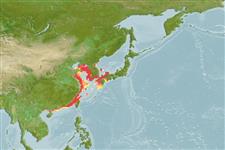Environment: milieu / climate zone / depth range / distribution range
Ecologie
marien; zoet water; brak water; anadroom (Ref. 51243); diepte 0 - 50 m (Ref. 189). Subtropical; 42°N - 21°N, 109°E - 134°E (Ref. 189)
Northwest Pacific: Canton north to Ariake Sound, southwestern Japan, including all of Yellow Sea and off western coasts of Korea. Penetrates over 1000 km up the Yangtze River.
Lengte bij maturiteit / Grootte / Gewicht / Leeftijd
Maturity: Lm ?, range 24 - 27 cm
Max length : 41.0 cm TL mannelijk / geslacht onbekend; (Ref. 189)
Dorsale stekels (totaal): 0; Anale stekels 0; Anale zachte stralen: 80. Body tapering, belly rounded before pelvic fins, with 16 to 26 + 25 to 36 = 43 to 61 keeled scutes from isthmus to anus. Maxilla long, reaching to or almost to base of first pectoral fin ray. Pectoral fin with 6 filaments; branched fin rays longer than those of pelvic fin.
Occurs in coastal waters, estuaries and reaching up to middle parts of rivers, apparently able to tolerate freshwater (Ref. 189, 11230). Lives in not really clean water but not really turbid water either (Ref. 12218). Goes to the deep water areas of rivers at night (Ref. 12218). Planktivore (Ref. 12218). Spawns around three times in a lifetime and spawning occurs in between reeds (Ref. 12218). In Ariake Sound, Japan it breeds from May to August, the fishes running about 15 km up the Chikugo River and spawning in freshwater, the spherical eggs floating down and hatching near the river mouth. Its relatively large size makes it a more esteemed food fish than most Coilia. Used in Chinese medicine (Ref. 12166).
Spawn in school (Ref. 205).
Whitehead, P.J.P., G.J. Nelson and T. Wongratana, 1988. FAO Species Catalogue. Vol. 7. Clupeoid fishes of the world (Suborder Clupeoidei). An annotated and illustrated catalogue of the herrings, sardines, pilchards, sprats, shads, anchovies and wolf-herrings. FAO Fish. Synop. 125(7/2):305-579. Rome: FAO. (Ref. 189)
Status op de Rode Lijst van het IUCN (Ref. 130435)
Gevaar voor de mens
Harmless
Gebruik door de mens
Visserij: commercieel
Meer informatie
ReferentiesAquacultuurAquacultuurprofielKweeklijnenGeneticaElectrophoresesErfelijkheidZiektesVerwerkingNutrientsMassaconversie
Tools
Speciale rapporten
Download XML
Internetbronnen
Estimates based on models
Preferred temperature (Ref.
123201): 12.3 - 25.2, mean 17.5 °C (based on 218 cells).
Fylogenetische diversiteitsindex (Ref.
82804): PD
50 = 0.5001 [Uniqueness, from 0.5 = low to 2.0 = high].
Bayesian length-weight: a=0.00251 (0.00190 - 0.00332), b=3.07 (3.02 - 3.12), in cm total length, based on LWR estimates for this species (Ref.
93245).
Trofisch niveau (Ref.
69278): 3.0 ±0.00 se; based on food items.
Generation time: 3.1 ( na - na) years. Estimated as median ln(3)/K based on 2
growth studies.
Weerstandsvermogen (Ref.
120179): Gemiddeld, minimale populatieverdubbelingstijd 1,4-4,4 jaar (K=0.35; tmax=5).
Fishing Vulnerability (Ref.
59153): Low to moderate vulnerability (25 of 100).
